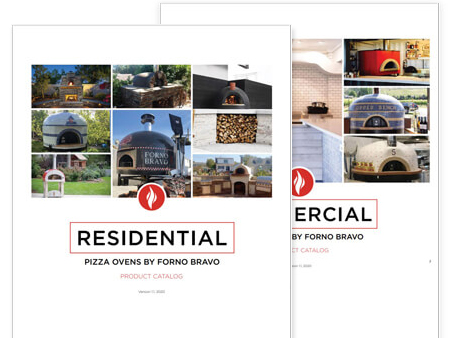The Cincinnati Post
Jun 17, 2004Posted by Forno Bravo![]()
Thursday, June 17, 2004
Italian pizzas follow ‘specs’
Staff and wire reports
As you might have heard from friends just back from Italy, the pizza experience is not quite the same in the home of its invention. The pizza as Americans know it has been, well, Americanized.
There’s the husband of a woman who had enrolled in an Italian cooking school one summer. He just wanted a pizza with sausage and pepperoni. He could only find it with eggplant. It seems that Americans have been spending the last few decades loading pizza crusts with toppings, but the original Neapolitan pizza encountered “over there” by World War II GIs was more modest in calories.
And then there’s the crust debate: thick or thin?
According to Forno Bravo, a California company that imports Italian wood-fire ovens to the United States, the Italian government has recently launched the Vera Pizza Napoletana movement (VPN) to try to protect true Neapolitan pizza.
They will soon be proposing the VPN specification to the European Union to be accepted as a Specialita Traditionale Garantita (STG). Pizzerias that closely follow the rules will be allowed to make true Pizza Napoletana and display the VPN logo.
The specifications clearly outline what Neapolitans think a real pizza should look and taste like. For example, a pizza must have a 0.1-inch-thick base (a little more than a credit card), must use fresh mozzarella, must be thrown by hand, must use extra virgin olive oil and must be cooked in a 900-degree wood-fired oven for no more than 90 seconds.
Forno Bravo has posted an English translation of the Italian Ministry of Agriculture’s Vera Pizza Napoletana (VPN) specification on its Internet site. The translation can be found at www.fornobravo.com/Pizzanapoletana/Pizzanapoletana.html, or by going to www.fornobravo.com, and clicking on Vera Pizza Napoletana.
Much like Chianti Classico, mozzarella, Parmesan and certain types of olive oil, the Italian government is working to protect the product and the name “Pizza Napoletana.” All the specifications grew out of a meeting of the most venerated Neapolitan pizzaioli (pizza makers), who compared notes, then reached an agreement on how to make the perfect pizza.
Restaurants certified to be Vera Pizza Napoletana compliant are allowed to display the VPN logo. A small number of U.S. restaurants are already VPN certified, including Niebaum-Copola in San Francisco, Calif.
“While it is tempting to poke fun at the fact that the Italians are so passionate about pizza that they created a specification for it, the Vera Pizza Napoletana movement is good for the average American consumer,” said James Bairey, a former Silicon Valley marketing executive living in Tuscany, and founder of Forno Bravo.
“It shows the world what Italy and the Neapolitans think a real pizza should look and taste like. I think the VPN movement shows us that we should be expecting more from our restaurants. We have a strong desire to do things right in the U.S. — and I think that includes food products.
“Look what we have accomplished with wine, beer and bread over the past decade, and think about what we can do with pizza.”
As the VPN proposal notes, evidence of pizza has been discovered in the excavations of virtually every ancient civilization. The brick ovens uncovered in Pompeii demonstrate sophisticated engineering, and with a little restoration, could start cooking again today.
“We want to see the brick oven as widely used in the U.S. as it is in Italy, where the wood fire oven rivals the barbecue in popularity,” Bairey said.
Forno Bravo sells ovens for both residential and restaurant use (suitable in the kitchen or garden). A typical wood-fired oven is $2,000. Shipment is from Healdsburg, Calif.
The company has developed relationships with Italy’s producers and artisans who build these ovens and has created installation products. For more information: www.fornobravo.com , or call (800) 407-5119.





